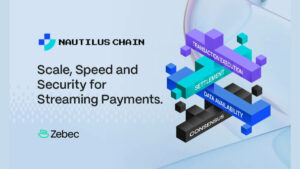As a crypto marketer and retail trader, I am constantly on the lookout for the next big trends in the industry. In this article, I will be sharing four crypto use cases that offer genuine value – so, no meme coins here! These use cases have the potential to gain mainstream adoption, and I will highlight their promising aspects. However, I will also discuss the potential obstacles that might hinder their path to widespread adoption. After all, it’s crucial not to have any blind spots when deciding to invest in something!
#1. Decentralized Physical Infrastructure (DePIN)
In a world shaped by centralization and corporate control, the emergence of Decentralized Physical Infrastructure Networks (DePIN) is truly revolutionary. By leveraging blockchain technology and peer-to-peer protocols, DePIN aims to transform the way we build and maintain physical networks.
DePIN comprises four primary categories (also see figure 1), each tailored to specific needs:
- Cloud/Storage Networks: This category encompasses a wide range of services, including file storage, relational databases, Content Delivery Networks (CDN), and Virtual Private Networks (VPN) systems.
- Wireless Networks: Vital technologies like 5G and LoRaWAN fall under this category, playing a crucial role in enabling the seamless functioning of Internet of Things (IoT) applications.
- Sensor Networks: Interconnected devices equipped with sensors form this category, facilitating the real-time collection of data from the physical world. This data is highly valuable for applications such as mapping technologies.
- Energy Networks: By aggregating distributed energy sources, DePIN seeks to establish a more robust and efficient energy grid, ensuring greater resilience in our energy infrastructure.
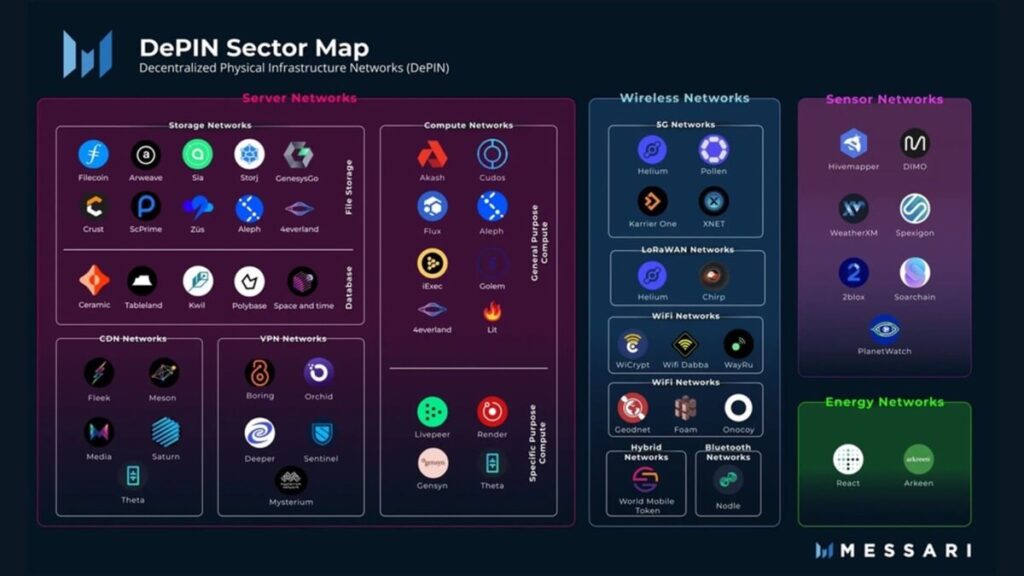
Why DePIN is set to explode?
Firstly, DePIN incentivizes a community of volunteers through crypto tokens, enabling infrastructure construction at a staggering 10-100 times faster pace compared to traditional methods, accelerating progress like never before.
Secondly, The decentralized nature of DePIN presents a unique advantage in hyper-local market alignment. By directly responding to specific demands, DePIN networks become more adaptable and responsive to the needs of communities, fostering greater efficiency and relevance.
Thirdly, DePIN is cost-effective. It alleviates the financial burden associated with infrastructure development. By offering more efficient and budget-friendly solutions, DePIN opens doors to endless possibilities for growth.
Furthermore, DePIN’s scalability across different jurisdictions in a permissionless manner is a crucial aspect of its potential widespread adoption. By eliminating unnecessary barriers and complexities, DePIN can easily transcend borders and become a global phenomenon.
Moreover, the concept of credibly neutral and collectively owned networks is yet another compelling feature of DePIN. By fostering trust and community participation, DePIN projects offer a transparent and democratic way to build and maintain vital infrastructure.
And lastly, DePIN’s integration with decentralized finance (DeFi) applications brings forth frictionless micropayments and seamless transactions, making it more accessible and user-friendly.
Obstacles to mainstream adoption of DePIN
Despite its enormous potential, DePIN does face certain challenges. Building applications and generating demand may take longer compared to consumer apps, requiring patience and perseverance. Another significant obstacle to adoption comes in the form of well-established web2 giants, such as Amazon, Microsoft, and Google, which pose a substantial disruption challenge. However, I believe that as more consumers recognize the benefits, DePIN’s influence and adoption are likely to continue expanding.
#2. Tokenized Real-World Assets
In my opinion, the tokenization of real-world assets is going to be another game-changer. Tokenization of real-world assets is converting tangible assets like real estate, precious metals, art, and collectibles into digital tokens on the blockchain. Tokenization extends not only to high-value items but also to Treasuries, currency, and stocks.
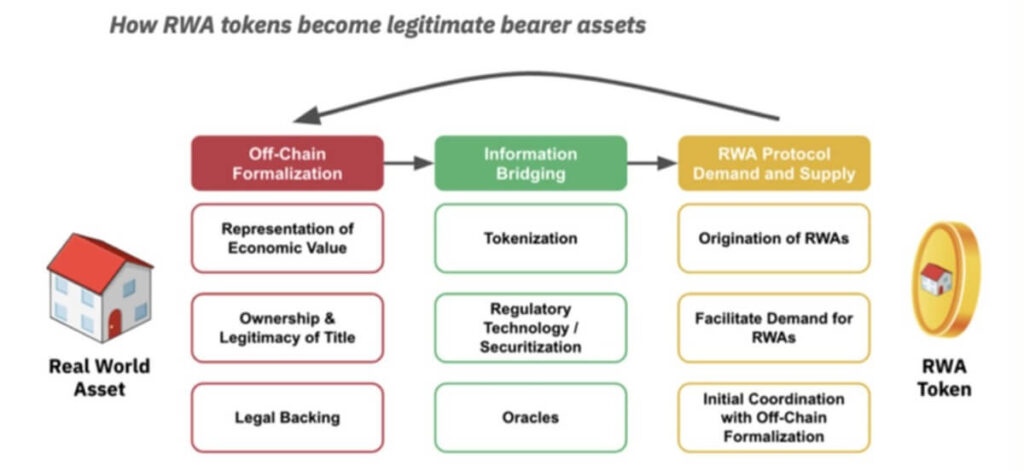
Why tokenized real-world assets will explode?
The potential of real-world asset tokenization to revolutionize the world lies in several aspects.
Firstly, it democratizes wealth creation and investment opportunities by offering fractional ownership, making traditionally illiquid markets more accessible to smaller investors. Real estate, in particular, stands to benefit significantly from tokenization, providing new yield opportunities in DeFi markets and enhancing liquidity and price discovery. Art and collectibles also undergo a transformation, with tokenization dividing ownership into multiple shares, democratizing the art market and combatting issues like forgery and fraud.
Furthermore, tokenization extends to intellectual property and patents, making it easier to manage, transfer, and monetize these assets 24/7.
Lastly, by tokenizing real-world assets, a reduction in costs can be achieved by eliminating intermediaries like lawyers and banks.
For these reasons, the future of tokenized assets appears very promising. Already, traditional finance firms show interest in tokenizing assets they currently trade. In the event of mainstream adoption, market projections indicate substantial growth potential, with the tokenized assets market estimated to soar to $16 trillion by the year 2030.
Obstacles to mainstream adoption of tokenized real-world assets
The biggest obstacle to broader adoption and institutional integration of tokenized assets is a regulatory one (see figure 3). Governments and regulatory bodies are still in the process of developing worldwide regulatory frameworks to ensure investor protection. I firmly believe that the barriers cited by insiders can be overcome. We just need time and patience.
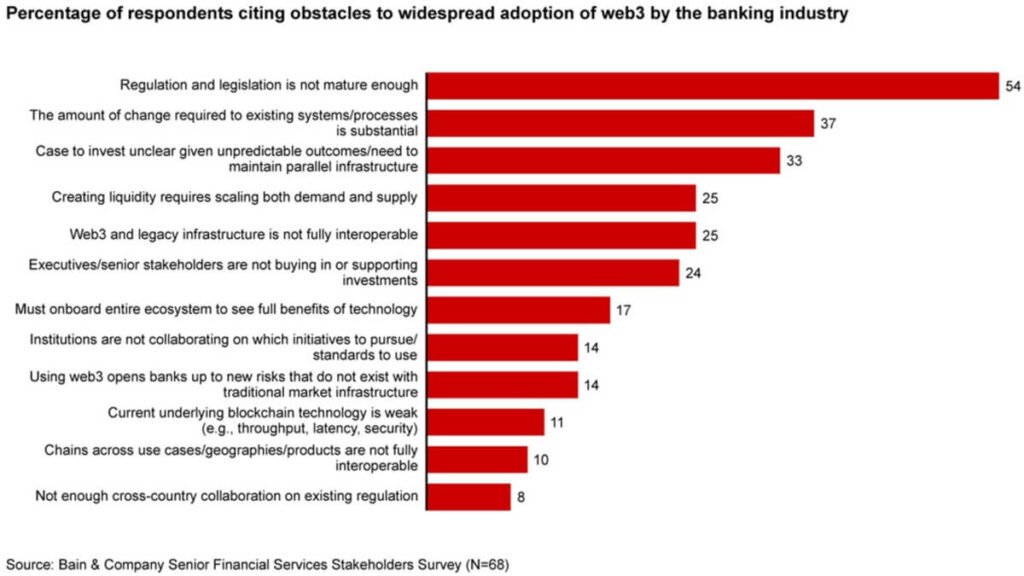
#3. Decentralized Exchanges
Decentralized crypto exchanges, also known as DEXs, have emerged as prominent alternatives to traditional centralized exchanges in the cryptocurrency market. Operating on decentralized platforms primarily using blockchain technology, DEXs facilitate direct peer-to-peer trading between users. Unlike centralized exchanges that rely on intermediaries to facilitate transactions and hold custody of user funds, DEXs allow users to interact directly with smart contracts on the blockchain, ensuring they retain full control over their private keys and wallets. This feature enhances the security of users’ assets, as they are not required to deposit funds into the exchange and are not subject to the risk of a central authority mishandling their funds.
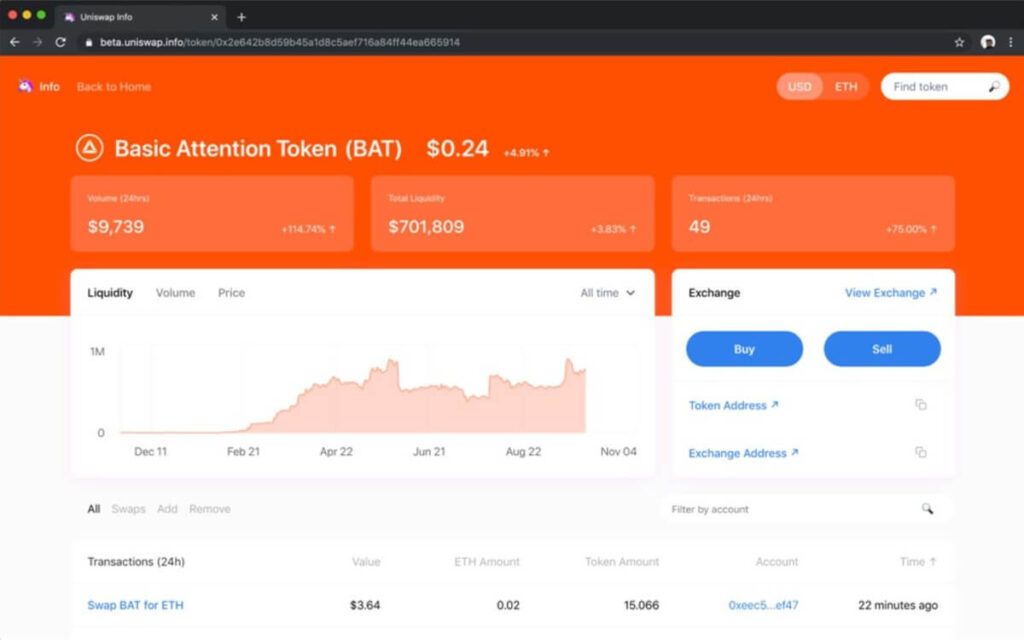
Why DEXs will explode?
DEXs have many advantages compared to CEXs. They are transparent, allow for privacy, and often have lower fees. But there are two specific reasons why I believe DEXs will explode.
The first one is that they offer non-custodial trading. By eliminating the need for a central authority to hold user funds, DEXs significantly reduce the risks associated with hacks or potential misuse of funds. Users’ funds remain in their possession until the trade is executed through the smart contract, enhancing the overall security of the exchange. This feature is becoming increasingly favored by more traders due to concerns about how centralized exchanges store and utilize their users’ funds, particularly in light of the FTX collapse.
The other reason is that DEXs offer global accessibility. They do not impose geographical restrictions on users, allowing anyone with an internet connection and a compatible cryptocurrency wallet to participate in trading. As such, DEXs are also accessible to individuals in regions with limited access to traditional financial services or in countries with strict cryptocurrency regulations. As such, more Americans started using DEXs after the SEC announced most of the alts to be securities.
Obstacles to mainstream adoption of DEXs
However, despite their numerous advantages, DEXs are not without challenges. One significant drawback is the lower liquidity compared to centralized exchanges. Centralized exchanges benefit from a larger pool of buyers and sellers, leading to higher liquidity, which is crucial for executing trades efficiently without impacting market prices significantly. In contrast, DEXs may experience price deviations and less favorable trading outcomes due to their smaller user base and trading volumes.
Another obstacle to mainstream adoption lies in the technical nature of decentralized exchanges. Users must have a certain level of familiarity with blockchain technology and compatible wallets to trade on DEXs effectively. The process of purchasing native platform tokens to pay for gas fees can also be complex for novice traders, potentially leading to asset losses in case of errors.
#4. Telegram Trading Bots
Telegram trading bots have taken the crypto industry by storm, with Unibot being one of the most well-known options. The main advantage of these bots lies in their seamless integration with users’ wallets and decentralized exchanges. By using simple chat commands, users can execute lightning-fast swaps with ease, while also setting stop-loss and take-profit orders even when offline, providing an extra layer of security. Moreover, the bots come equipped with anti-rug and honeypot features, protecting users from potential token developer scams.
Telegram trading bots also provide a range of advanced features, including yield farming and copy trading, which enable users to replicate successful trades made by experienced traders. They also support multi-wallet sniping, granting users more freedom in their trading by bypassing individual wallet restrictions on tokens.
However, these bots aren’t solely focused on trading; they also serve as valuable sources of real-time market data, offering trading signals and technical analysis to empower users’ decision-making. Additionally, they facilitate peer-to-peer transactions and even act as payment services for businesses.
Why TG crypto bots will explode?
Firstly, operating these bots is simple. They rely on automated scripts that respond to specific commands or keywords within a Telegram chat. Secondly, Telegram boasts over 700 million users, making it a powerful platform that simplifies the DeFi experience and increases accessibility. Thirdly, we can witness growing adoption, with projects earning significant revenues. Unibot and Maestro have both secured positions in the top 10 highest-earning protocols within the crypto industry. In just the last two months, Unibot’s revenue has skyrocketed by over 100 times, resulting in an impressive $650,000 earned in a single day.
Obstacles to mainstream adoption for Telegram trading bots
While there are plenty of reasons to be excited, it’s essential to exercise caution regarding potential security tradeoffs. While the bots claim to delete access to users’ accounts, concerns about wallet security persist. To mitigate risks, it is advisable to connect a separate wallet to the bot and transfer only the necessary funds for trading purposes.
Conclusion
In conclusion, the crypto industry is definitely still innovating, and the next big use cases are poised to transform the way we perceive and engage with finance, infrastructure, and technology. Beyond the use cases mentioned here, there are countless more on the horizon, waiting to be explored. As a trader and tech enthusiast, staying alert and embracing new opportunities is not just important but also super exciting! So stay curious!
About the Author
Kevin Van Dorp, Co-founder of CoinScouts.io
I have experience in marketing and project management within the blockchain industry. Previously, I worked as a marketer for Woo Network and served as a project manager for several blockchain projects, including Gamee (Animoca), Chiliz, Pastel Network, Alium, MyDeFiPet, and Seascape. Currently, I am passionately involved in a pet project called CoinScouts. CoinScouts aims to keep crypto traders informed about the latest crypto project developments and provide valuable insights into blockchain trends.
Read Also: A Mix of Anticipation and Skepticism Building for the Next Bull Run
- SEO Powered Content & PR Distribution. Get Amplified Today.
- PlatoData.Network Vertical Generative Ai. Empower Yourself. Access Here.
- PlatoAiStream. Web3 Intelligence. Knowledge Amplified. Access Here.
- PlatoESG. Automotive / EVs, Carbon, CleanTech, Energy, Environment, Solar, Waste Management. Access Here.
- PlatoHealth. Biotech and Clinical Trials Intelligence. Access Here.
- ChartPrime. Elevate your Trading Game with ChartPrime. Access Here.
- BlockOffsets. Modernizing Environmental Offset Ownership. Access Here.
- Source: https://alexablockchain.com/future-forward-crypto-use-cases-mainstream-potential/
- :has
- :is
- :not
- 000
- 1
- 10
- 100
- 2030
- 5G
- 700
- a
- About
- accelerating
- access
- accessibility
- accessible
- Accounts
- achieved
- across
- Act
- Additionally
- Adoption
- advanced
- ADvantage
- advantages
- After
- aims
- Alert
- All
- allow
- Allowing
- already
- also
- alternatives
- am
- Amazon
- Americans
- an
- analysis
- and
- Animoca
- announced
- Another
- anticipation
- any
- anyone
- applications
- apps
- ARE
- Art
- article
- AS
- aspect
- aspects
- asset
- Asset Tokenization
- Assets
- associated
- At
- authority
- Automated
- Banks
- barriers
- base
- BCG
- BE
- become
- becoming
- before
- being
- believe
- benefit
- benefits
- between
- Beyond
- Big
- Biggest
- binance
- blind
- blockchain
- blockchain industry
- blockchain projects
- blockchain technology
- blockchain trends
- boasts
- bodies
- borders
- Bot
- both
- bots
- Brings
- broader
- build
- Building
- bull
- burden
- businesses
- but
- buyers
- by
- called
- CAN
- case
- cases
- categories
- Category
- caution
- central
- central authority
- Centralization
- centralized
- Centralized Exchanges
- certain
- CEXs
- challenge
- challenges
- Chiliz
- cited
- claim
- Co-founder
- Coins
- Collapse
- collectibles
- collection
- collectively
- come
- comes
- Communities
- community
- compared
- compatible
- compelling
- complex
- complexities
- comprises
- concept
- Concerns
- conclusion
- Connect
- connection
- constantly
- construction
- consumer
- Consumers
- content
- continue
- contract
- contracts
- contrast
- control
- converting
- copy trading
- Corporate
- cost-effective
- Costs
- countries
- creation
- crucial
- crypto
- Crypto Exchanges
- Crypto Industry
- CRYPTO TOKENS
- crypto traders
- crypto use
- crypto use cases
- cryptocurrency
- cryptocurrency market
- Cryptocurrency Regulations
- Cryptocurrency Wallet
- Currency
- Currently
- Custody
- data
- databases
- day
- decentralized
- Decentralized Finance
- decentralized finance (DeFi)
- decentralized-exchanges
- Deciding
- Decision Making
- DeFi
- definitely
- delivery
- Demand
- demands
- democratic
- democratizes
- Democratizing
- deposit
- Despite
- Developer
- developing
- Development
- developments
- Devices
- Dex
- DEXs
- different
- digital
- digital tokens
- direct
- directly
- discovery
- discuss
- Disruption
- distributed
- do
- does
- doors
- due
- each
- Earning
- ease
- easier
- easily
- effectively
- efficiency
- efficient
- efficiently
- eliminating
- embracing
- emerged
- emergence
- empower
- enable
- enabling
- encompasses
- Endless
- energy
- engage
- Enhances
- enhancing
- enormous
- ensure
- ensuring
- enthusiast
- equipped
- Errors
- essential
- establish
- estate
- estimated
- Even
- Event
- exchange
- Exchanges
- excited
- execute
- executed
- executing
- Exercise
- expanding
- experience
- experienced
- Explored
- extends
- extra
- Face
- facilitate
- facilitating
- Fall
- Familiarity
- farming
- faster
- favorable
- Feature
- Features
- Fees
- Figure
- File
- finance
- Finance firms
- financial
- financial services
- firmly
- firms
- First
- focused
- For
- form
- forth
- fostering
- four
- fractional
- frameworks
- fraud
- Freedom
- frictionless
- from
- FTX
- ftx collapse
- full
- functioning
- funds
- future
- Gain
- game-changer
- Gamee
- GAS
- gas fees
- generating
- genuine
- geographical
- giants
- Global
- going
- Governments
- granting
- greater
- Grid
- Growing
- Growth
- growth potential
- hacks
- Have
- here
- higher
- Highlight
- highly
- hinder
- hold
- horizon
- How
- However
- http
- HTTPS
- i
- impacting
- important
- impose
- impressive
- in
- incentivizes
- Including
- Increases
- increasingly
- indicate
- individual
- individuals
- industry
- influence
- informed
- Infrastructure
- innovating
- insights
- Institutional
- integration
- intellectual
- intellectual property
- interact
- interconnected
- interest
- intermediaries
- Internet
- internet connection
- internet of things
- into
- Invest
- investment
- investment opportunities
- investor
- investor protection
- Investors
- involved
- iot
- issues
- IT
- items
- ITS
- jpg
- jurisdictions
- just
- Keep
- keys
- keywords
- known
- larger
- Last
- latest
- Lawyers
- layer
- leading
- less
- Level
- leveraging
- lies
- light
- lightning-fast
- like
- likely
- Limited
- limited access
- Liquidity
- longer
- LoRaWAN
- losses
- lower
- made
- Maestro
- Main
- Mainstream
- mainstream adoption
- maintain
- Making
- manage
- management
- manager
- manner
- many
- mapping
- Market
- Market Data
- Market Prices
- Marketing
- Markets
- max-width
- May..
- meme
- Meme Coins
- mentioned
- Metals
- methods
- micropayments
- Microsoft
- might
- million
- mishandling
- misuse
- Mitigate
- mix
- monetize
- months
- more
- more efficient
- Moreover
- most
- multiple
- must
- my
- native
- Nature
- necessary
- Need
- needs
- network
- networks
- Neutral
- never
- New
- next
- no
- non-custodial
- novice
- numerous
- obstacle
- obstacles
- of
- offer
- offering
- offline
- often
- on
- ONE
- only
- opens
- operating
- Opinion
- opportunities
- Options
- or
- orders
- Other
- our
- outcomes
- over
- overall
- Overcome
- owned
- ownership
- Pace
- page
- participate
- participation
- particular
- particularly
- pastel network
- Patents
- path
- Patience
- Pay
- payment
- Payment Services
- peer to peer
- Peer-to-Peer Transactions
- permissionless
- perseverance
- pet
- phenomenon
- physical
- platform
- Platforms
- plato
- Plato Data Intelligence
- PlatoData
- playing
- Plenty
- poised
- pool
- positions
- possession
- possibilities
- potential
- potentially
- powerful
- Precious
- Precious Metals
- presents
- previously
- price
- Prices
- primarily
- primary
- privacy
- private
- Private Keys
- process
- Progress
- project
- project management
- projections
- projects
- prominent
- promising
- property
- protecting
- protection
- protocols
- provide
- providing
- purchasing
- purposes
- range
- real
- real estate
- real world
- real-time
- reason
- reasons
- recognize
- reduce
- reduction
- regarding
- regions
- regulations
- regulatory
- relevance
- rely
- remain
- required
- resilience
- Respond
- responding
- responsive
- restrictions
- resulting
- retail
- retain
- revenue
- revenues
- revolutionary
- revolutionize
- Risk
- risks
- robust
- Role
- Scalability
- scams
- scripts
- seamless
- SEC
- Secured
- security
- see
- Seeks
- Sellers
- sensors
- separate
- serve
- Services
- set
- setting
- several
- shaped
- Shares
- sharing
- show
- signals
- significant
- significantly
- Simple
- single
- Skepticism
- smaller
- smart
- smart contract
- Smart Contracts
- So
- solely
- Solutions
- Source
- Sources
- specific
- spots
- stands
- started
- stay
- Still
- Stocks
- storage
- store
- Storm
- strict
- subject
- substantial
- successful
- such
- Super
- support
- Swaps
- Systems
- tailored
- Take
- taken
- tech
- Technical
- Technical Analysis
- Technologies
- Technology
- Telegram
- that
- The
- The Future
- the world
- their
- There.
- These
- they
- things
- this
- Through
- time
- times
- to
- token
- Tokenization
- tokenized
- tokenized assets
- tokenizing
- Tokens
- top
- Top 10
- trade
- trader
- Traders
- trades
- Trading
- Trading Bots
- trading volumes
- traditional
- traditional finance
- traditionally
- Transactions
- transfer
- Transform
- Transformation
- transparent
- Treasuries
- Trends
- truly
- Trust
- two
- under
- undergo
- unique
- Uniswap
- unlike
- until
- use
- User
- user funds
- user-friendly
- users
- using
- utilize
- Valuable
- value
- very
- Virtual
- vital
- volumes
- volunteers
- VPN
- Waiting
- Wallet
- Wallets
- Way..
- we
- Wealth
- Web2
- well-known
- when
- which
- while
- why
- wide
- Wide range
- widespread
- will
- with
- within
- without
- witness
- Woo
- woo network
- worked
- world
- worldwide
- year
- yet
- Yield
- yield farming
- zephyrnet



